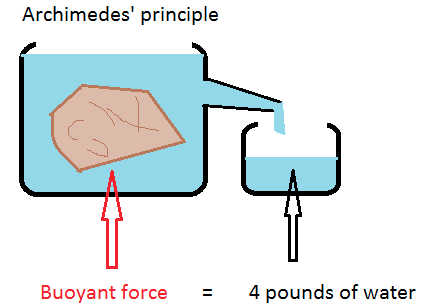Buoyancy and Archimedes' principle
The Archimedes' principle was named after Greek philosopher Archimedes.
The principle is closely related to buoyancy as you can see in the
statement below.

Here is what Archimedes states:
The buoyant force acting on an object that is submerged in water is equal to the weight of the liquid the object displaces.
Whether the object is partially submerged or not, the principle is still true.
For example, suppose you submerge a rock in water whose weight is 10 pounds and the water that is displaced has a weight of 4 pounds, what is the buoyant force?
Since the rock displaced 4 pounds of water and the buoyant force is equal to the weight of the liquid that the object displaces, the buoyant force is 4 pounds.
Notice that it is not the weight of the object that determine the buoyant force, but the weight of the displaced water. This situation is illustrated in the figure above.
The strength of the force beneath the rock that pushes the rock up is equal to 4 pounds.
Other real life examples of Archimedes' principle.
- You fill your bathtub with water and you submerge your body in the bathtub. Some water will spill on the ground. The weight of the water that fell on the floor is equal to the buoyant force that pushes your body up.
- A boat on a river will be partially submerged. The boat will displace an amount of water even if it is small. The weight of the water that was displaced is equal to the buoyant force at the bottom of the boat.